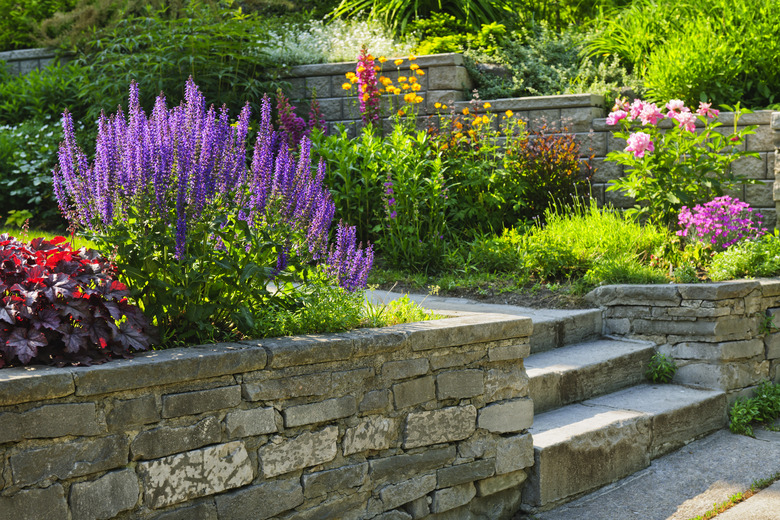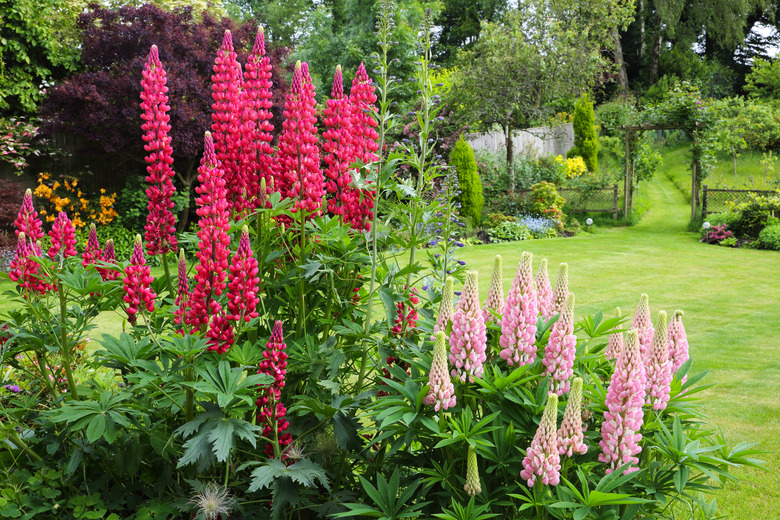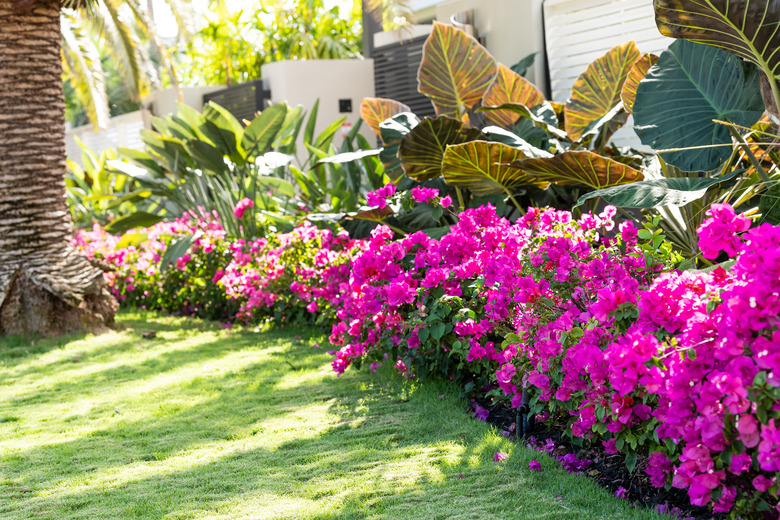A Beginner's Guide To Planning A Flower Garden
We may receive a commission on purchases made from links.
The first step in the process of planning a flower garden is to decide what you want from it, and if you're like most people, visual interest is probably at the top of your priorities list. Flowers do much more than look pretty, though. They attract birds, bees and other pollinators, they help manage weeds and control insects and some even provide health benefits in the form of medicinal teas and ointments. You probably want some of these perks along with the aesthetic benefits that come with flower gardening.
When it comes to designing your flower bed, you have to start with what you have, including available space, soil type and climate zone, and you have to stay within the realm of feasible possibilities when working toward what you want. You can't plan on growing tropical wildflowers if you live in a cool, arid location — but that doesn't mean you can't have color and texture. Nature in all its diversity provides an abundance of variety for every growing zone, and who knows what surprises are in store? A good flower garden design tip is to be realistic and plan for a miracle.
Plan the Layout of Your Flower Garden
Plan the Layout of Your Flower Garden
Every garden bed, no matter how expansive, has a finite size and discrete boundaries, so before you even think about which plants you want to grow, you should measure the available space and lay out the borders. It isn't a bad idea to draw the garden plan on graph paper to give yourself a schematic view so you can choose flowers not just for color but also for other characteristics, such as height and the amount of space they need. Make an effort to combine textures. Some plants, such as lavender (Lavandula spp.), are dense and bushy and produce a large number of small flowers, while others, like irises (Iris spp.), are stately and majestic, and the combination creates harmony and balance.
On flat ground, you'll probably want ground-hugging plants, such as hostas (Hosta spp.), in the front and around the borders and the tallest plants in the back, but if the land slopes, the situation could be reversed. Taller plants — such as coneflowers (Echinacea spp.), a deer-resistant perennial flower that produces deep-orange blooms in midsummer — near the front could effectively frame colorful, low-growing vegetation that becomes the focal point by virtue of being on a hill. Combining highly textured coneflowers, a perennial that blooms with yellow, pink or white flowers in summer, with yellow coreopsis (Coreopsis spp.) that has more finely textured foliage, both of which may grow to 3 feet tall, provides interesting textures that vary throughout the season.
Color is obviously important in a flower garden, and you should choose colors that enhance, blend with and unify the existing landscaping while creating drama in some places and peacefulness in others. A color wheel is a useful tool when planning a color scheme. Colors close to each other on the wheel tend to be relaxing in combination, while colors on opposite sides of the wheel create dramatic contrast.
The colors of a flower garden change with the season, so part of planning the color scheme is mixing and matching bloom time and appreciating the difference between a perennial bloom that recurs year after year, such as a coneflower or aster (Symphyotrichum spp.), and an annual one that dies off when winter approaches, as a geranium (Pelargonium spp.) does in most growing zones.
Understand What Will Grow
Understand What Will Grow
Know your climate zone, which you can look up on the United States Department of Agriculture zone map, to avoid choosing plants unsuitable for your location. This is especially important when you purchase seeds online. Some flowers thrive in a wide range of zones, while others are suited for a fairly narrow range. Some flowers bloom quickly, while others take a long time. You should also take into account the average dates of the first and last frost of the season as well as the average rainfall you get during the growing season. When in doubt, native wildflowers that grow in nearby fields are always a good bet because they are already adapted to local conditions.
Observe the amount of sunlight each part of the proposed garden plot gets at different times of the day so you can put plants in spots where they'll get the sunlight they need. Not all flowers prefer full sun; some, such as phlox (Phlox spp.), are woodland plants adapted to living in the shadows of large trees and are good candidates for shady spots. Unless you plan to be in the garden all day every day, your list of plants should include at least some low-maintenance varieties, such as cosmos (Cosmos spp.), so you can devote what time you do have to your more finicky roses (Rosa spp.).
A soil test is also in order, and while the best way to test it is to take a sample to a garden center or your local university extension for analysis, you can also measure nutrient levels with a store-bought kit. You can also determine the concentrations of soil types (silt, clay and sand) by mixing a sample in a glass of water, letting it settle and observing the layers. Some of the plants you were hoping to include may not thrive if the clay layer on top or the sand layer, which will settle on the bottom, is too thick.
Combine Plants in Groups
Combine Plants in Groups
One of the secrets to a thriving garden is that plants are growing close to other plants with which they have an affinity. By themselves, roses are vulnerable to a host of pests and diseases, but they may need a lot less maintenance if you plant nearby alliums (Allium spp.), which repel aphids; geraniums, which repel rose beetles; or marigolds (Tagetes spp.), which repel many garden pests. These companion plants also look great in combination with roses.
Combining perennials with annuals allows you to change the color palette of your garden each year. In combination, bee balm (Monarda spp.), clematis (Clematis spp.) and mugwort (Artemisia spp.) — all perennials — create a cheerful red, white and blue backdrop for yearly plantings. This year, you may want to highlight upright stalks of delicate lavender-colored angelonia flowers (Angelonia spp.) against this backdrop, and next year, you can plant mums (Chrysanthemum spp.), dahlias (Dahlia group) or geraniums for more robust texture and more dramatic color variations.
When it comes to vegetables, there are several combinations that you should avoid — for example, tomatoes (Lycopersicon esculentum) and bush beans (Phaseolus vulgaris) — but flowers tend to get along better as long as you avoid combining plants that require vastly different growing conditions, like butterfly weed (Asclepias spp.) and impatiens (Impatiens spp.), or ones that grow large and shade out the neighboring ones. Too much of a single type of flower can also be a bad thing because that makes it easier for diseases that affect that plant to spread. If your flower garden is next to your vegetable garden, avoid planting sunflowers (in multiple genera) on the border because the seeds release toxins that may inhibit the growth of some veggies, such as potatoes (Solanum tuberosum) and pole beans (Phaseolus spp.).
Collect Your Tools
Collect Your Tools
All those plants aren't going to get in the ground by themselves, so a major part of any garden plan is figuring out which tools you need and making sure you have them on hand. You'll need at least one round-point shovel for turning the earth and a hand trowel for digging small holes, and it doesn't hurt to have a spade for planting saplings and bushes and for cutting borders. Don't forget the wheelbarrow, which you'll need to transport dirt, compost and mulch.
Weeds are going to pop up — they always do — so get a weeding tool so you can pull them out by the roots. This tool is likely to come in handy even before you start planting, especially if you use it in conjunction with a hoe. You'll also need a garden rake to move dirt around and a leaf rake to remove leaves and dead foliage. Of course, no DIY garden is complete without a good-quality garden hose; expandable ones are great if you don't have much extra space in the yard.
At some point (maybe not right away), you're going to need pruning shears and possibly a pruning saw to clear overhanging tree branches. Finally, get yourself a good pair of garden gloves and a hat to protect yourself from getting too much of that healing sunshine.


